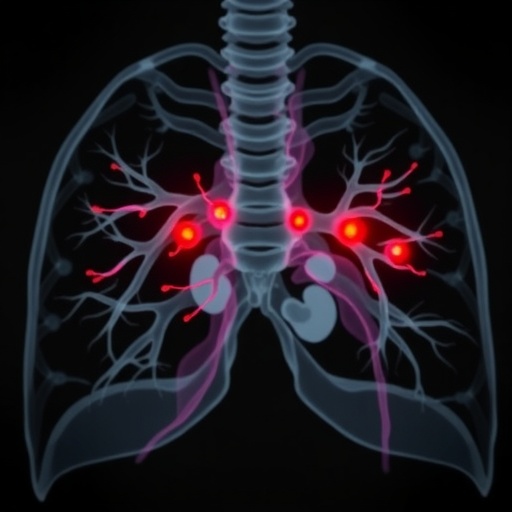In the realm of infectious diseases, the interplay between viral infections and autoimmune disorders is a burgeoning field of study that continues to unravel the complexities of human health. A recent case report published by Liang, Chen, and Zheng sheds light on a particularly intriguing intersection: the relationship between Mycoplasma pneumoniae infection and aquaporin-4-positive neuromyelitis optica spectrum disorder (NMOSD). This groundbreaking work emphasizes not only the potential for certain infections to trigger autoimmune responses but also highlights the necessity for vigilance in diagnosing and managing patients presenting with neurological symptoms following respiratory infections.
Mycoplasma pneumoniae, a unique bacterium lacking a cell wall, is well-known for its role in respiratory infections, particularly among children and young adults. Unlike traditional bacterial pathogens, Mycoplasma pneumoniae can lead to a range of clinical manifestations, including atypical pneumonia and extrapulmonary complications. Though generally self-limiting, its infections have been linked to autoimmune phenomena, prompting researchers to investigate the underlying mechanisms that associate this pathogen with immune-mediated conditions such as NMOSD.
Neuromyelitis optica spectrum disorder is characterized by significant and debilitating effects on the central nervous system, most notably the optic nerves and spinal cord, and is often marked by severe episodes of inflammation and demyelination. Aquaporin-4 (AQP4) antibodies are present in a significant number of NMOSD cases, aiding in the differentiation of this disorder from multiple sclerosis and other similar conditions. The binding of these antibodies to AQP4, a water channel protein found in astrocytes, leads to the destruction of host cells and results in the distinctive symptomatic picture seen in affected individuals.
The case outlined by Liang et al. involves a patient who developed NMOSD symptoms following an acute Mycoplasma pneumoniae infection. This case serves as a poignant example of how a seemingly benign respiratory pathogen can initiate a cascade of immune responses, culminating in severe neurological dysfunction. The patients’ clinical features, along with laboratory findings that confirmed the presence of AQP4 antibodies, underscore the importance of considering NMOSD when faced with neurological symptoms post-infection.
Investigations into the pathophysiological mechanisms underlying this intersection reveal a fascinating interplay between infection and autoimmunity. The activation of autoreactive T cells during a Mycoplasma pneumoniae infection can inadvertently trigger an autoimmune response against self-antigens, such as AQP4. This phenomenon suggests a potential viral mimicry or bystander activation, where the immune system, in its fervor to combat the pathogen, mistakenly targets host cells expressing similar antigens.
To date, there has been limited literature discussing the direct association between Mycoplasma pneumoniae infections and NMOSD. However, the evidence presented in this case report, along with the authors’ thorough literature review, emphasizes an urgent need for further research. The rarity of such cases does not imply that the association does not exist; rather, it points to the complexity and variability of immune responses and the potential for underdiagnosis in clinical settings.
The implications of this research extend beyond the individual case presented. It highlights crucial aspects of patient management, including the need for heightened awareness among clinicians treating individuals with respiratory infections. Early recognition of neurological symptoms and subsequent investigations could facilitate timely diagnosis of NMOSD, which is critical for effective management and can drastically alter the trajectory of the disease.
Treatment strategies for NMOSD, particularly when secondary to infections like those caused by Mycoplasma pneumoniae, may necessitate a multifaceted approach. Immunotherapy, often a cornerstone of NMOSD management, must be balanced with the need to treat the underlying infection. This dual consideration complicates treatment protocols but underscores the necessity for collaboration among infectious disease specialists and neurologists.
Moreover, the findings call for the establishment of clinical guidelines to aid in the recognition and referral of patients developing neurological symptoms after respiratory infections. These guidelines must include recommendations for serological testing for AQP4 antibodies in appropriate scenarios, thus potentially streamlining the diagnostic process for NMOSD.
A breakthrough in understanding the relationship between an infection and an autoimmune disorder such as NMOSD may pave the way not only for more effective therapeutic approaches but also for preventive strategies. Vaccination against Mycoplasma pneumoniae, while not currently available, could emerge as a topic for future research endeavors.
In conclusion, the report from Liang, Chen, and Zheng contributes significantly to the literature on infectious diseases and autoimmunity. It serves as a crucial reminder of the intricate relationships that exist within the human body and how an infection can dramatically alter immune dynamics. As we advance our understanding of these connections, the potential for improved diagnosis and treatment increases, heralding a future where knowledge translates into better patient outcomes.
This case report stands as a clarion call for medical professionals to maintain a high index of suspicion for rare but significant complications following common infections. As research continues to unfold in this field, the hope is that such cases will inform clinical practice, guiding effective management and ultimately improving quality of care for affected individuals.
In summary, the exploration of the nuances between infectious agents and autoimmune responses represents an essential frontier in medical research. The case of Mycoplasma pneumoniae infection precipitating NMOSD is a vivid illustration of the complexities involved in these conditions and serves as an impetus for ongoing investigation.
Subject of Research: The relationship between Mycoplasma pneumoniae infection and aquaporin-4-positive neuromyelitis optica spectrum disorder.
Article Title: Mycoplasma pneumoniae infection and concurrent aquaporin-4-positive neuromyelitis optica spectrum disorder: a case report and literature review.
Article References:
Liang, H., Chen, Y. & Zheng, P. Mycoplasma pneumoniae infection and concurrent aquaporin-4-positive neuromyelitis optica spectrum disorder: a case report and literature review.
BMC Pediatr 25, 765 (2025). https://doi.org/10.1186/s12887-025-06155-w
Image Credits: AI Generated
DOI: 10.1186/s12887-025-06155-w
Keywords: Mycoplasma pneumoniae, neuromyelitis optica spectrum disorder, aquaporin-4, autoimmune response, respiratory infections, case report.
Tags: aquaporin-4 antibodiesatypical pneumonia complicationsautoimmune disorders and infectious diseasesautoimmune responses to infectionscase report on Mycoplasma pneumoniae.central nervous system inflammationdemyelination and optic nerve effectsimmune-mediated conditionsMycoplasma pneumoniae infectionneuromyelitis optica spectrum disorderpediatric respiratory infectionsrespiratory infections and neurological symptoms





